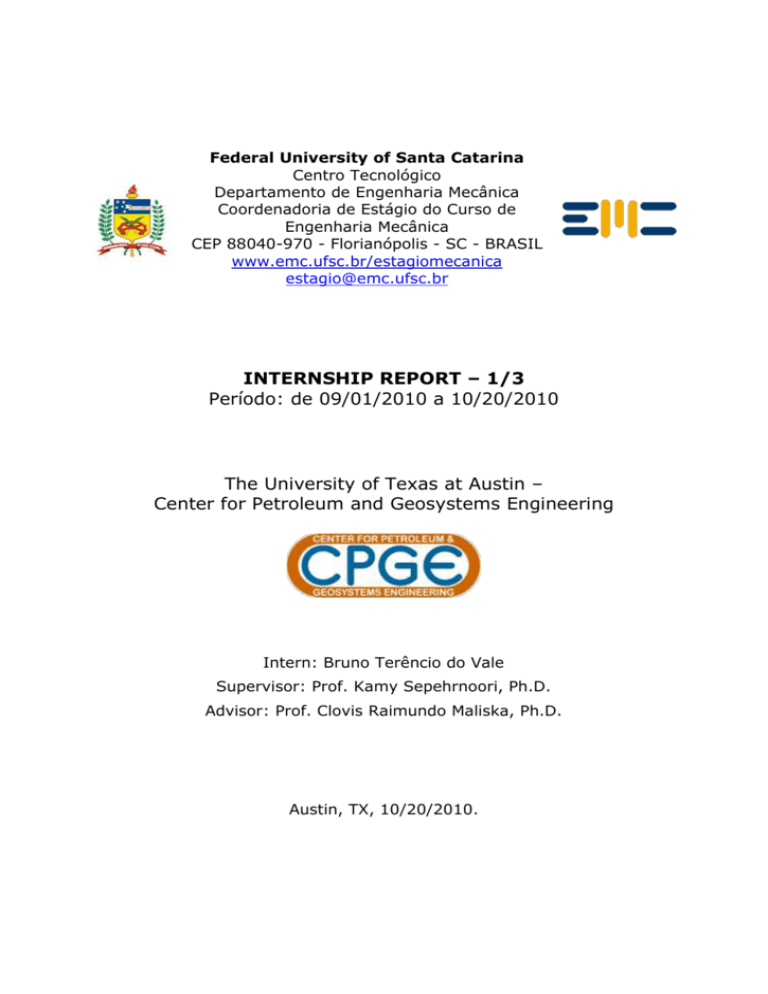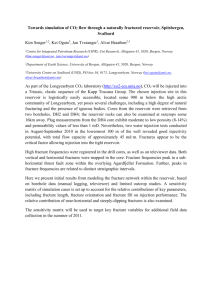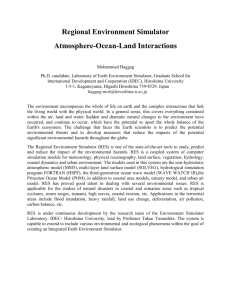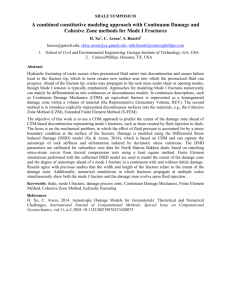GRUPPE I - EM-UFSC
advertisement

Federal University of Santa Catarina Centro Tecnológico Departamento de Engenharia Mecânica Coordenadoria de Estágio do Curso de Engenharia Mecânica CEP 88040-970 - Florianópolis - SC - BRASIL www.emc.ufsc.br/estagiomecanica estagio@emc.ufsc.br INTERNSHIP REPORT – 1/3 Período: de 09/01/2010 a 10/20/2010 The University of Texas at Austin – Center for Petroleum and Geosystems Engineering Intern: Bruno Terêncio do Vale Supervisor: Prof. Kamy Sepehrnoori, Ph.D. Advisor: Prof. Clovis Raimundo Maliska, Ph.D. Austin, TX, 10/20/2010. Institution, work areas and products The University of Texas at Austin (also referred to as UT or UTAustin) is a public research university located in Austin, Texas, USA. Founded in 1883, the university has the fifth largest single-campus enrollment in the nation as of fall 2009 (and had the largest enrollment in the country from 1997–2003), with over 50,000 students, 2,900 faculty, and 21,000 staff members. The Center for Petroleum and Geosystems Engineering Research (CPGE), located on the main campus, is where this internship takes place. CPGE has, as missions, the objectives to encourage and develop interdisciplinary research in petroleum and geosystems engineering as well as other areas related to energy and the environment, to provide educational opportunities for graduate students, to provide an organizational structure for funding new areas of research and conduct meetings, symposia, and workshops on research topics, and to provide a mechanism for technology transfer. The center works with a large range of projects, including environmental engineering, drilling, well completions, rock mechanics, and production engineering. Prof. Kamy Sepehrnoori, supervising this work, oversees research projects and teaches courses primarily focusing on computational methods in the area of reservoir engineering, natural gas engineering, and integrated reservoir characterization. In the area of reservoir simulation, research activities include reservoir modeling and simulation as well as model developments, such as wettability alteration, geomechanics, unstructured grid, naturally fractured reservoirs, and compositional models. With this knowledge, the development and the maintenance of simulators for enhanced oil recovery (EOR) processes, such as GPAS (General Purpose Adaptive Simulator - a fully implicit parallel compositional simulator) and the UTCHEM (IMPEC – implicit pressure, explicit concentration - compositional chemical flooding simulator) can be performed. Introduction This is the first report written to detail my activities at CPGE. The internship concerns the last semester of the undergraduate course of mechanical engineering at the Federal University of Santa Catarina (UFSC), standing as a requirement for the completion of the course. The internship has an initial duration of six months – from September 1, 2010, until February 28, 2011 – and takes place at The University of Texas at Austin, in the Center for Petroleum and Geosystems Engineering, in the area of numerical simulation of multiphase flow in fractured-porous media. There is a growing interest in naturally fractured hydrocarbon reservoirs, since the behavior presented by a multiphase flow in such reservoirs cannot be modeled as a single-phase flow in a porous media. As Monteagudo and Firoozabadi (2004) explain, “fractured-porous media are composed of rock matrix and fractures […] Often the rock matrix provides the storage, and in single-phase flow, fractures provide the fluid flow path. In two-phase flow, fractures may provide the flow path of one phase and the less permeable matrix can provide the flow path of the other phase […] The flow path of a phase in multiphase flow is affected by capillary, gravity, diffusion/dispersion, and viscous forces”. There are many situations in which multiphase flow in fracturedporous media occurs, which has raised economic interest. Multiphase flow in subsurface fractured-hydrocarbon formations is of high interest in hydrocarbon production (Monteagudo and Firoozabadi, 2004). Another example of multiphase flow in fractured-porous media is the analysis of water and non-aqueous-phase liquids flow in fractured media. However, the main reason for the need of this study comes from the fact that naturally fractured formations comprise to 20% of the world’s petroleum and natural gas reserves. It is worth mentioning that it is common to generate fractures in the reservoir during the drilling of a well to improve the permeability in the proximity of the wellbore. Proposed work The objective of this work relates to The University of Texas chemical compositional simulator (UTCHEM) simulator, an IMPEC simulator, particularly to the part of the code that uses the Element-based Finite Volume Method (EbFVM). Since this method enables the use of unstructured meshes in two- and three-dimensions, ensuring flexibility in representing the complex geometries in reservoirs, the implementation of a discrete fracture model is the main objective of this work. Overview UTCHEM is a 3D, multi-component, multiphase, compositional, nonisothermal simulator used for modeling chemical flooding processes. This simulator accounts for complex phase behavior and the transport of chemicals and hydrocarbons in heterogeneous porous media that can be used both for groundwater analysis and for oilfield applications. The mass conservation equation for each species, the energy balance, and the aqueous phase pressure equations are used in this program. For the first set of equations, the boundary conditions are no flow or dispersive flow on the impermeable boundaries. The boundary condition for the energy balance equation is that the energy is only a function of the temperature and the energy flux in the media occurs just by advection and diffusion. The boundary condition for the pressure equation is obtained by an overall mass balance on volume-occupying components (water, oil, surfactant, co-solvent, and gas), substituting Darcy’s law for the phase flux terms and noting that the sum of the concentration of all components is equal to one. The other phase pressures are computed by adding the capillary pressure between phases. As result of its initial implementation, the UTCHEM simulator originally used the finite difference method, requiring a structured mesh (Cartesian, radial, or curvilinear). However, the use of that kind of mesh, in the case of complex geometries or in the local refinement of wells and faults, common in real situations, shows restrictions. Based on this evidence, a new line of research was started, resulting in a new version of the UTCHEM simulator working with EbFVM. That method was, and is, widely studied in the SINMEC – Computational Fluid Dynamics Laboratory, at the Federal University of Santa Catarina, providing the intern some familiarity with the method. Figure 1 – Control volume assembling in EbFVM The EbFVM methodology was implemented in the UTCHEM simulator. As this method uses more flexibility in mesh generation, additional features are being developed for the software. The objective of this work will be carried out with the implementation of a discrete fracture model in the code. A similar implementation was performed for GPAS, the fully implicit simulator aforementioned. Therefore, that software will be used as a reference for this internship. For the implementation of the naturally fracture model, one can use the dual porosity and the dual permeability models. Both methods, however, have some drawbacks in the representation of complex fracture configurations. These methods do not use mesh flexibility gained by the EbFVM method, which is the main motivation for this research. An alternative for these models is the discrete-fracture model. Moreover, when compared with the dual-porosity/dual-permeability models, the discrete-fracture model offers several advantages (Monteagudo and Firoozabadi, 2004): It can account explicitly for the effect of individual fractures on fluid flow. There is no need to compute the exchange term between the matrix and the fracture. The performance of the method is not affected by very thin fractures. The discrete fracture modeling takes much more computational time than the dual porosity models; however, the discrete fracture model is more accurate. Work Plan A plan for this work is shown below. The chart shows the tasks for this work and the duration of each task. The work plan will be revised as the work continues based on the time needed to complete the tasks. September October November December January February Overview Implementation Validation Approach In the process to include the discrete fracture model in the UTCHEM simulator, some steps have to be performed: Identify the fractures in the mesh file (the fractures, in the mesh, should always go through the edges of the elements; the user can simply indicate the nodes in which the fracture is present). Figure 2 – Representation of the fracture (thick line) in an unstructured mesh Provide the data needed to fully characterize the problem (like the thickness and the porosity of the fracture). Include the contribution of the flow of the fracture in the balance equations in each volume that contains a stretch of the fracture. The last step is interesting in the discrete fracture model since there is no need to create two separate systems of equations, which decreases the computational time. There is just one system of equations, in which both the matrix and fractures are considered. This occurs through the integration of the equations of both systems using the superposition principle. Figure 3 – Control volume cell: (a) unfractured and (b) fractured media. To create the meshes that will be used in the validation cases, a program called GID most likely will be used. For the post-processing of data, the software that will be used is called Kraken, developed and licensed by ESSS - Engineering Simulation and Scientific Software Ltd., a simulation company based in Florianopolis with a long list of works in conjunction with SINMEC. With Kraken, the simulations results of the UTCHEM simulator can be visualized and analyzed, allowing the comparison of its results with the results of other commercial simulators such as ECLIPSE, IMEX, and Stars. Results During the first month of research, an extensive review was carried out, including topics such the FORTRAN 90, in which the code of UTCHEM is written, the model formulation of the UTCHEM simulator (studied through the UTCHEM user guide and the UTCHEM Technical Manual), the discrete fracture model, the IMPEC method, the UTCHEM simulator (specifically, the EbFVM implementation part of the code), and the GPAS simulator (particularly, the discrete fracture model part of the code). Future Work For the next month, the objective is to begin working on the code and become familiar with the mesh generator program. With regard to the code, the necessary data will be inserted in the mesh file (geometry) and the UTCHEM input file (properties). With that information, the next step will be changing the conservation equations, so that it considers the effects of fractures. References 1. Karpinski, L., Maliska, C. R., Marcondes, F., Delshad, M., Sepehrnoori, K. “An Element Based Conservative Approach Using Unstructured Grids in Conjunction with a Chemical Flooding Compositional Reservoir Simulator”, XX International Congress of Mechanical Engineering - COBEM, Gramado, RS, Brazil, 2009. 2. Marcondes, F., Varavei, A., Sepehrnoori, K. “An Element-Based Finite-Volume Method Approach for Naturally Fractured Compositional Reservoir Simulation”, 13th Brazilian Congress of Thermal Sciences and Engineering – ENCIT, Uberlândia, MG, Brazil, 2010. 3. Monteagudo, J. E. P., Firoozabadi, A. “Control-Volume Method for Numerical Simulation of Two-Phase Immiscible Flow in Two- and Three-Dimensional Discrete-Fractured Media”, Water Resources Research, Vol. 40, 2004. 4. Monteagudo, J. E. P., Firoozabadi, A. “Comparison of Fully Implicit and IMPES Formulations for Simulation of Water Injection in Fractured and Unfractured Media”, International Journal for Numerical Methods in Engineering, vol. 69, p. 698-728, 2007. 5. Karpinski, L. “UTCHEM – EbFVM User’s GUIDE (Based on UTCHEM 9.9 User’s GUIDE)”, Center for Petroleum and Geosystems Engineering – CPGE, The University of Texas at Austin, Austin, TX, 2009. 6. UTCHEM-9.0. User’s Guide for UTCHEM-9.0: A Three-Dimensional Chemical Flood Simulator, Volume I, Reservoir Engineering Research Program, Center for Petroleum and Geosystems Engineering – CPGE, The University of Texas at Austin, Austin, TX, 2008. 7. UTCHEM-9.0. Technical Documentation for UTCHEM-9.0 - A ThreeDimensional Chemical Engineering Research Flood Simulator, Program, Center Volume for II, Reservoir Petroleum and Geosystems Engineering – CPGE, The University of Texas at Austin, Austin, TX, 2000.








